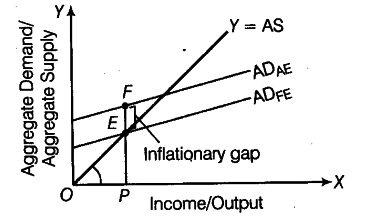Explain the concept of inflationary gap. Also explain the role of legal reserves in reducing it.
or
Define and represent inflationary gap on a diagram. Explain the role of the varying reserves requirement in removing the gap.
Inflationary gap occurs when AD>AS corresponding to full employment level. This inflationary gap, i.e. excess of Aggregate Demand causes inflation in the economy and price levels tend to rise.

In this figure,
{{AD}_{FE}} = AD at full employment level
{{AD}_{AE}} = AD above full employment level
The point E is the equilibrium point where AD= AS. But there is excess demand (current) at {{AD}_{AE}}, where Aggregate
Demand FP is more than the Aggregate Supply in the economy. This difference of actual Aggregate Demand and
Supply, i.e. EF is the inflationary gap.
Inflationary Gap = Excess Demand = {{AD}_{AE}} -
{{AD}_{FE}} = EF
Role of Legal Reserves to Correct the Problem of Inflationary Gap
Legal reserves like Cash Reserve Ratio and Statutory Liquidity Ratio are the tools to correct the problem of inflationary
gap:
(i) Cash Reserve Ratio (CRR) Each and every commercial bank has to keep a certain proportion of its demand and time deposits in the form of cash and other liquid assets with the Central Bank. This ratio is termed as Cash Reserve Ratio. To correct the problem of inflationary gap, the Central Bank increases the CRR. It reduces the supply of money and credit creation capabilities of commercial banks. Due to lesser supply of money, the Aggregate Demand comes down and the economy attains equilibrium situation.
(ii) Statutory Liquidity Ratio (SLR) It refers to a fixed percentage of the total assets of a bank in the form of cash or other liquid assets that is required to be maintained by the bank. During the situation of inflationary gap, SLR is increased. This reduces the credit creation capacity of commercial banks and reduces the flow of money in the economy. As a result of that, the Aggregate Demand comes down and ultimately, the economy attains equilibrium.